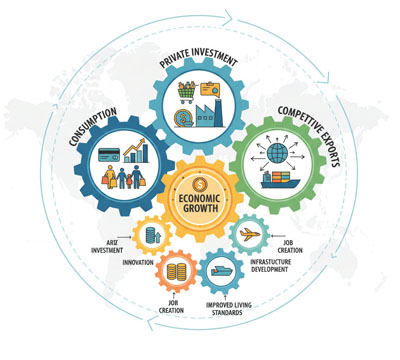A granular examination of record Diwali spending reveals a nuanced interplay between genuine consumer confidence and residual pent-up demand, particularly sweeping GST cuts amid an evolving inflation landscape. Urban salaried cohorts, particularly in premium segments, such as electronics, travel, and jewellery, reflect true confidence, underpinned by stable employment in services and tangible real wage gains compared to 2022–23.
However, the surge in travel, leisure, and big-ticket durables still carry a “catch-up” component following past supply bottlenecks and deferred purchases. While headline inflation has moderated from its 2022–23 peaks, intermittent spikes in food prices, especially vegetables and pulses, imply that part of the nominal record spending remains price-led rather than volume-led.
Will Festive Consumption Sustain PFCE or Taper Post-Season?
Historically, some moderation in consumption is typical after the festive season, yet Private Final Consumption Expenditure (PFCE) is likely to remain modestly positive, provided food inflation subsides and urban labour markets stay resilient.
Persisting risks include a renewed food inflation uptrend eroding rural purchasing power; exhaustion of pent-up demand elongating replacement cycles in the absence of fresh income growth; and tighter liquidity and higher borrowing costs tempering discretionary spending.
 However, structural tailwinds are government capex multipliers boosting incomes in construction and logistics; wage revisions and DA hikes for government employees; and digitization lowering transaction frictions in commerce.
However, structural tailwinds are government capex multipliers boosting incomes in construction and logistics; wage revisions and DA hikes for government employees; and digitization lowering transaction frictions in commerce.
Going forward, attention should pivot to Quarterly National Accounts to track real PFCE growth relative to GDP, supported by high-frequency indicators, such as e-way bills, FASTag collections, UPI and card transactions, auto retail data (FADA), and consumer durable volumes.
Urban Demand Outpaces Rural Consumption
Urban demand continues to outstrip rural consumption in discretionary categories, viz., electronics, premium FMCG, QSR chains, and travel, driven by sustained income stability and premiumization trends in metros and Tier-I cities.
Rural India, though showing signs of recovery where monsoons were adequate, remains price-sensitive and exhibits downtrading in areas affected by food inflation and weak agricultural terms of trade. The recovery, therefore, is not yet broad-based.
To ensure balanced momentum, policy levers aimed at strengthening rural purchasing power by timely MSP adjustments, calibrated PM-KISAN disbursements, and targeted subsidies are critical. Rural health can be better gauged through FMCG volume growth, tractor and two-wheeler sales, fertilizer offtake, mandi prices, and sowing trends, rather than premium product sales.
External Trade Headwinds: Watching the Export Mix
Should the U.S. impose new tariff or non-tariff barriers on specific sectors, e.g., apparel, chemicals, paper, or steel derivatives, India’s export growth in those lines could soften, partially offsetting domestic demand gains. But India’s export basket is well-diversified, viz., IT services, pharmaceuticals, gems and jewellery, and engineering goods. Services exports continue to provide a buffer.
While domestic demand can absorb short-term external drag, persistent goods export weakness could pressure manufacturing capacity utilization and capex plans. Continuous monitoring is essential by tracking sectoral export growth to the U.S. and EU, order book trends, compliance costs (sustainability, labour due diligence), merchandise trade deficit vs. services surplus, and INR competitiveness for a full assessment.
Credit Growth and Banking Liquidity: Adequate but Watchful
Systemic credit growth remains healthy in the mid-teens for retail borrowers and stable for MSMEs. However, unsecured lending has slowed amid tighter prudential norms, and NBFC funding costs have edged up.
 Episodes of liquidity deficit, driven by tax outflows or festival cash withdrawals, have necessitated active liquidity management. With real policy rates now positive, exuberance is contained without choking off credit to quality borrowers.
Episodes of liquidity deficit, driven by tax outflows or festival cash withdrawals, have necessitated active liquidity management. With real policy rates now positive, exuberance is contained without choking off credit to quality borrowers.
As long as deposit mobilization keeps pace and inflation remains moderate, credit availability should support continued spending. But a prolonged liquidity shortfall or sharp rise in term deposit rates could compress banking margins (NIMs) and curb lending appetite. Close tracking of LAF liquidity, credit-deposit ratios, RBI stance, and delinquency trends, especially in unsecured and SME segments, will be the key to anticipating macro shifts.
Fiscal and Policy Effects: Pre-Election Dynamics
The Centre remains committed to fiscal consolidation while preserving high public capex, which is critical for job creation and income support in construction and manufacturing value chains. Targeted transfers such as PM-KISAN, calibrated food and fertilizer subsidies, LPG support, and DA/DR hikes will bolster real disposable incomes, particularly for lower-income groups.
Timely disbursement of such measures and wage revisions can drive short-cycle consumption, while consolidation curbs broad-based fiscal excess. Fuel taxation, meanwhile, remains a key swing factor influencing both headline inflation and consumer sentiment. Budget execution, especially capex vs. revenue spending, subsidy allocations, and state-level cash schemes, will shape the near-term demand trajectory.
Can Consumption-Led Growth Endure Without Investment and Exports?
Sustained growth cannot rely solely on consumption. Without a revival in private investment and export expansion, the current momentum risks becoming urban-skewed, credit-fuelled, and inflation-sensitive.
Durable 7%+ growth demands all three engines—consumption, private capex, and exports—firing together. This requires a decisive private capex upturn in PLI-linked sectors, housing, data centers, and renewables; export diversification into higher-value segments like electronics, specialty chemicals, and auto components; and an accent on services export resilience.
Tracking RBI OBICUS capacity utilization, corporate order books, housing starts, PLI disbursements, FDI flows, and export market share gains will provide the best leading indicators of sustainability.
Pathway to the Future
The festive consumption surge is real but partly price- and catch-up-driven. While urban momentum remains robust, rural breadth hinges on food inflation moderation and targeted policy support.
External headwinds and intermittent liquidity tightness appear manageable in the near term, but policymakers must resist the temptation to extrapolate festive buoyancy into a structural boom.
For India to achieve durable, inclusive 7%+ real growth, the three engines, viz., consumption, private investment, and competitive exports, must work in tandem. Only then can the current festive exuberance transform from a seasonal spike into a sustained growth trajectory, and this consumption boost is not just a flash in the pan but is sustainable over the long haul.
The task ahead is difficult, but with sincerity of purpose and redoubled efforts, it can certainly be done. What is required is to go full steam ahead and fire on all cylinders. I am reminded of President John F. Kennedy’s remarks in his Inaugural Address, “With a good conscience our only sure reward, with history the final judge of our deeds, let us go forth to lead the land we love, asking His blessing and His help, but knowing that here on earth God’s work must truly be our own”. These are powerful and inspiring thoughts. I am confident that if we conduct ourselves in this manner, we will certainly have ‘His blessing and His help’.
ABOUT THE AUTHOR
 Dr. Manoranjan Sharma is Chief Economist, Infomerics, India. With a brilliant academic record, he has over 250 publications and six books. His views have been cited in the Associated Press, New York; Dow Jones, New York; International Herald Tribune, New York; Wall Street Journal, New York.
Dr. Manoranjan Sharma is Chief Economist, Infomerics, India. With a brilliant academic record, he has over 250 publications and six books. His views have been cited in the Associated Press, New York; Dow Jones, New York; International Herald Tribune, New York; Wall Street Journal, New York.








